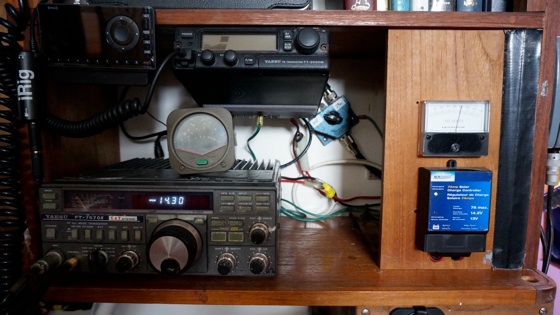Ground Definitions
On a ship there are many "grounds":
Ship's DC power supply ground. Usually the negative side of the main battery.
Bonding system ground. Wires that connect all the through hulls together.
Ship's AC power safety ground. The green wire on a three pin plug.
Lightning ground. Heavy wires used to connect the mast, to the external keel or to a grounding plate.
Radio ground or RF ground.
When we say "ground" we refer to RF GROUND and on a boat that means the SEA. So to avoid confusion with the "grounds" above, we will call the RF GROUND simply "the sea". The sea absorbs and reflects the radiowaves from the antenna and either improves or makes worse communications with distant stations. In a proper radio installation, the antenna system is designed to make use of the sea to improve communications.
COUNTERPOISE
Sometimes it is impossible to take advantage of the sea as a natural RF ground, and a counterpoise, or artificial ground, is substituted. For example: A VHF antenna mounted more than six feet above the sea (on a pole or at the top of a mast where the added height improves the range) is so far away from the sea that a counterpoise is called for. Sometimes you will see horizontal wires sticking out from the base of a VHF antenna, like the whiskers on a cat. This is the counterpoise. The wires are usually four in number and 1/4 wavelength long. A counterpoise is not esthetic to many people, so you see them on few vessels. The advantage of using a counterpoise at VHF is that radiation efficiency is better, with the benefit that communications range is increased. On SSB, the vertical antennas are mounted close to the sea which is, in any case, a much better RF ground than a counterpoise.
More about GROUNDS
The Electric current that is sent out by the transceiver to the radiator is recaptured by the RF ground system. The RF ground system 'collects' the electric current at a point close to the base of the radiator and then returns it to the transceiver along the outer shield of the transmission line (co-ax cable).
The quality of the RF ground system has some effect on your ability to send message to distant locations. This is because the strength of the RF radio waves carrying your message depends upon the strength of the electric current which travels in the radiator and is returned to the transceiver. This depends somewhat on the quality of the RF ground system. A good RF ground system will collect the maximum electric current that the transceiver can generate. Surprisingly some antenna modeling programs show that the type and size of the ground system on a vertical antenna has less impact on the transmitted signal than the height of the vertical antenna above the water. (For best signal the base of the vertical should be about 0.05 wavelengths above the water. For 20 meters, this is 1 meter above the water - pretty convenient, eh?) But I have found on my boat that the ground system can make a significant difference in signal reports from other HAMS. So there is obviously a difference in operation between a vertical antenna on the land, and the backstay antenna on a boat.
Here is shown the solar charger for the Nav equipment, and the voltmeter. This is limited to 7 Amperes, and the solar panel puts out only 3.5 A. The battery is 32 A-H, and on a sunny day it will get about 20 A-H, which is enough to recharge the battery after 10 hours of listening, or one hour of transmission time, which is plenty of time to talk with other amateurs.






